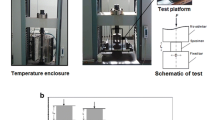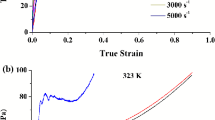Abstract
It is well known that polycarbonate (PC) undergoes time-dependent deformation (i.e., creep deformation), and nonlinear creep deformation is often experienced at high stress level. Using the time–temperature–stress superposition principle (TTSSP), we obtain a new master curve, which covers higher stress level, and successfully establish a new modeling method of creep deformation of PC. First, to investigate the effect of applied stress level on the creep compliance (i.e., stress-dependent nonlinear creep deformation), this study conducted various creep tests with eight different stress levels. We found that the creep compliance curve strongly depended on the applied stress level; in particular, a higher stress level induced a larger difference in creep compliance. According to the TTSSP, the creep compliance curve at each stress level shifts with the creep time (i.e., stress reduced time). When we appropriately selected the stress reduced time, we obtained the master curve of creep compliance, which is unified with respect to various applied stresses. However, we found that the stress-shifted factor is not compliant with the previous TTSSP, especially in the higher stress regime. Therefore, this regime was also considered to obtain a new master curve that can cover a wide range of stress levels. Finally, our established creep model (master curve and stress shift factor) was introduced into FEM, and then this numerical model was verified by comparison with experimental data. Our model may be useful for predicting the creep deformation of PC subjected to a wide range of applied stresses.









Similar content being viewed by others
References
Z.N. Yin and T.J. Wang, Deformation Response and Constitutive Modeling of PC, ABS and PC/ABS Alloys Under Impact Tensile Loading, Mater. Sci. Eng., A, 2010, 527, p 1461–1468
K. Cao, X. Ma, B. Zhang et al., Tensile Behavior of Polycarbonate Over a Wide Range of Strain Rates, Mater. Sci. Eng., A, 2010, 527, p 4056–4061
M. Ito, Y. Masuda, and K. Nagai, Evaluation of Long-Term Stability and Degradation on Polycarbonate Based Plastic Glass, J. Polym. Eng., 2014, 35, p 31–40
T. Sakai and S. Somiya, Analysis of Creep Behavior in Thermoplastics Based on Visco-Elastic Theory, Mech. Time-Depend. Mater., 2011, 15, p 293–308
M.L. Williams, R.F. Landel, and J.D. Ferry, The Temperature Dependence of Relaxation Mechanisms in Amorphous Polymers and Other Glass-forming Liquids, J. Am. Chem. Soc., 1955, 77, p 3701–3707
T. An, R. Selvaraj, S. Hong, and N. Kim, Creep Behavior of ABS Polymer in Temperature-Humidity Conditions, J. Mater. Eng. Perform., 2017, 26, p 2754–2762
A. Bozorg-Haddad and M. Iskander, Comparison of Accelerated Compressive Creep Behavior of Virgin HDPE Using Thermal and Energy Approaches, J. Mater. Eng. Perform., 2011, 20, p 1219–1229
L.C.E. Struik, Physical aging in amorphous polymers and other materials, Elsevier, London, 1978
D. Cangialosi, H. Schut, Veen Av, and S.J. Picken, Positron Annihilation Lifetime Spectroscopy for Measuring Free Volume during Physical Aging of Polycarbonate, Macromolecules, 2003, 36, p 142–147
B. Xu, Z. Yue, and X. Chen, Analysis of Damage During Bending Creep Tests, Philos. Mag. Lett., 2009, 89, p 335–347
W. Luo, C. Wang, R. Zhao et al., Creep Behavior of Poly(Methyl Methacrylate) with Growing Damage, Mater. Sci. Eng., A, 2008, 483–484, p 580–582
G.U. Losi and W.G. Knauss, Free Volume Theory and Nonlinear Thermoviscoelasticity, Polym. Eng. Sci., 1992, 32, p 542–557
W.G. Knauss and I. Emri, Volume Change and Nonlinearly Thermo-Viscoelasticity Constitution of Polymers, Polym. Eng. Sci., 1987, 27, p 86–100
P.A.O. Connel and G.B. McKenna, Large Deformation Response of Polycarbonate: Time-Temperature, Time-Aging Time, and Time-Strain Superposition, Polym. Eng. Sci., 1997, 37, p 1485–1495
B. Bernstein and A. Shokooh, The Stress Clock Function in Viscoelasticity, J. Rheol., 1980, 24, p 189–198
J. Lai and A. Bakker, Analysis of the Non-linear Creep of Highdensity Polyethylene, Polymer, 1995, 36, p 93–99
W. Luo, T. Yang, and Q. An, Time-Temperature-Stress Equivalence and Its Application to Nonlinear Viscoelastic Materials, Acta Mech. Solida Sin., 2001, 14, p 195–199
S. Jazouli, W. Luo, F. Bremand, and T. Vu-Khanh, Application of Time-Stress Equivalence to Nonlinear Creep of Polycarbonate, Polym. Test., 2005, 24, p 463–467
J. Kichenin, K.D. Van, and K. Boytard, Finite-Element Simulation of a New Two-Dissipative Mechanisms Model for Bulk Medium-Density Polyethylene, J. Mater. Sci., 1996, 31, p 1653–1661
H. Lu, B. Wang, J. Ma et al., Measurement of Creep Compliance of Solid Polymers by Nanoindentation, Mech. Time Depend. Mater., 2003, 7, p 189–207
R. Seltzer and Y.-W. Mai, Depth Sensing Indentation of Linear Viscoelastic-Plastic: A Simple Method to Determine Creep Compliance, Eng. Fract. Mech., 2008, 75, p 4852–4862
W. Luo, C. Wang, X. Hu, and T. Yang, Long-Term Creep Assessment of Viscoelastic Polymer by Time-Temperature-Stress Superposition, Acta Mech. Solida Sin., 2012, 25, p 571–578
R.A. Schapery, On the Characterization of Nonlinear Viscoelastic Materials, Polym. Eng. Sci., 1969, 4, p 295–310
S.C. Yen and F.L. Williamson, Accelerated Characterization of Creep Response of an Off-Axis Composite Material, Compos. Sci. Technol., 1990, 38, p 103–110
W. Brostow, Time-Stress Correspondence in Viscoelastic Materials: An Equation for the Stress and Temperature Shift Factor, Mater. Res. Innov., 2000, 3, p 347–351
W.J. MacKnight and J.J. Aklonis, Introduction to Polymer Viscoelasticity, Vol 2, Wiley-Interscience Publication, London, 1983
N. Inoue, A. Yonezu, Y. Watanabe et al., Prediction of Asymmetric Yield Strengths of Polymeric Materials at Tension and Compression Using Spherical Indentation, J. Eng. Mater. Technol., 2017, 139, p 0210021–02100211
H. Zamanian, B. Marzban, P. Bagheri, and M. Gudarzi, On Stress Concentration Factor for Randomly Oriented Discontinuous Fiber Laminas with Circular/Square Hole, J. Sci. Eng., 2013, 3, p 7–18
S.P. Zaoutsos, G.C. Papanicolaou, and A.H. Carbon, on the Non-Linear Viscoelastic Behaviour of Polymer-Matrix Composites, Compos. Sci. Technol., 1998, 58, p 883–889
A.M. Vinogradov, V.H. Schmidt, G.F. Tuthill, and W.G. Bohannan, Damping and Electromechanical Energy Losses in the Piezoelectric Polymer PVDF, Mech. Mater., 2004, 36, p 1007–1016
D. Ikeshima, A. Yonezu, and L. Liu, Molecular Origins of Elastoplastic Behavior of Polycarbonate Under Tension: A Coarse-Grained Molecular Dynamics Approach, Comput. Mater. Sci., 2018, 145, p 306–319
Y. Higuchi and M. Kubo, Coarse-Grained Molecular Dynamics Simulation of the Void Growth Process in the Block Structure of Semicrystalline Polymers, Modell. Simul. Mater. Sci. Eng., 2016, 24, p 1–13
K. Hagita, H. Morita, and H. Takano, Molecular Dynamics Simulation Study of a Fracture of Filler-Filled Polymer Nanocomposites, Polymer, 2016, 99, p 368–375
MSCsoftware. Marc® 2012 Volume D: User Subroutines and Special Routines.
M. Fukuhara and A. Sampei, Low-Temperature Elastic Moduli and Dilational and Shear Internal Friction of Polycarbonate, Jpn. J. Appl. Phys., 1996, 35, p 3218–3221
Acknowledgments
This work is supported by the JSPS KAKENHI (Grant No. 17K06062) from the Japan Society for the Promotion of Science (JSPS) and by a research grant from the Suga Weathering Technology Foundation (SWTF) (No. 67).
Author information
Authors and Affiliations
Corresponding author
Additional information
Publisher's Note
Springer Nature remains neutral with regard to jurisdictional claims in published maps and institutional affiliations.
Rights and permissions
About this article
Cite this article
Ikeshima, D., Matsuzaki, A., Nagakura, T. et al. Nonlinear Creep Deformation of Polycarbonate at High Stress Level: Experimental Investigation and Finite Element Modeling. J. of Materi Eng and Perform 28, 1612–1617 (2019). https://doi.org/10.1007/s11665-019-03945-z
Received:
Revised:
Published:
Issue Date:
DOI: https://doi.org/10.1007/s11665-019-03945-z




